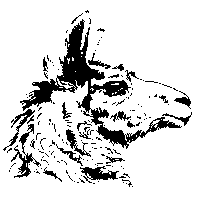 Rabbits
Rabbits
The domestic rabbit, Oryctolagus cuniculus, is a langomorph, not a rodent. They are descended from the wild rabbits of western Europe and northwestern Africa. Wild rabbits are gregarious, burrowing, herbivorous, nocturnal or crepuscular animals. The young are born hairless and blind in hair-lined nests.
The domestic rabbit comes in a variety of sizes, shapes and colors. Many breeds of rabbits are recognized by rabbit breeders associations. The largest breeds include the Giant Chinchilla and the Flemish Giant at 14-16 pounds. Medium sized breeds include the Californian and the New Zealand rabbits at 4- 14 pounds. The small breeds include the Polish and Dutch breeds at 2-4 pounds. The Angora is used for its fiber, often spun by handspinners right off the rabbit. Fiber is plucked or combed, not shorn. Hares (jackrabbits) and cottontail rabbits are not closely related and cannot cross breed.
[ Menu ]
Rabbits as Pets
Rabbits make good pets and can be house trained (to a litter box). Older individuals may become territorial and occasionally bite. However, biting by rabbits is very uncommon. If improperly handled or frightened, they can inflict scratches with their powerful back legs. Rabbits should be spayed or neutered to make the best pets (more later), and then, can live together without problems of fighting.
[ Menu ]
Housing
Housing options include: an outdoor hutch (either bought or made by you... plans are available from the library, feed store or extension agents, etc), an enclosed outdoor run with wire below the ground (they burrow), inside “rabbit house” with the run of the house under supervision, whatever. You need to remember that they need a lot of space to move around. Also needed are : proper ventilation; protection from the cold (below 40°F) by having an enclosed area within the cage; and protection from the heat (above 85°F) by cooling with ventilation, shade, frozen water in gallon milk bottles in the cage and/or overhead water sprinklers (don’t wet the rabbit). Rabbits need to be protected from drafts, predators, insects and vermin.
[ Menu ]
Feeding and Water
Rabbits should be fed a nutritious, wholesome, pelleted diet containing 12% to 22.5% crude fiber and 14%-17% crude protein. A once-a-day feeding will maintain an adult at a constant weight (medium sized rabbit should get 3-4 ounces or 2/3 cup). Rabbits require dietary fiber levels that are greater than those required by other species. They do not digest all the fiber on the first passage but fiber is important. Rabbits are naturally coprophagous and usually ingest large quantities of protein and vitamin rich “night stool” in the early morning. This is an important source of vitamins for them, do not prevent it!
[ Menu ]
Life Span
The average rabbit lives 4-5 years, but the record is 15-18 years (different sources). I have never seen one older than 11 years and generally 7-8 years old is really old. In the wild, the average rabbit doesn’t live past 9 months of age, mostly due to disease, starvation and predation.
[ Menu ]
Handling, Medical Care and Moms
The rabbit’s skeleton is very light weight for its size and muscle mass. It accounts for only 8% of its body weight compared to a cat’s 13%. Therefore, certain bones are very susceptible to injury, especially the long bones and lumbar spine. Fractures can occur from being dropped or just from being picked up incorrectly. The rabbit can overextend its back and break its back (spine) while struggling to escape by wiggling or kicking vigorously. Please support the back legs and hind end of the rabbit when you pick them up. If you don't know how, have someone who does show you. It is okay to use the loose skin behind the neck to help pick up the rabbit but never use the ears!
Rabbits may need their toenails trimmed on a regular basis if they do not have a way to wear them down. Feet can get caught in wire cages and the rabbit may sit quietly for days, so check for activity and movement. Rabbit’s incisors (front teeth) are continuously growing. If they do not wear them down by eating or if they are not positioned correctly in their mouth (genetic condition known as malocclusion), then the teeth must be trimmed or the rabbits teeth will grow too long. This can lead to infection, starvation and death.
Diet changes must be made slowly, especially if the rabbit is very young. Digestive upsets can lead to death.
Female rabbits are susceptible to uterine tumors and should be spayed at an early age. It is best to neuter male rabbits kept as pets to reduce territoriality and urine spraying.
Multiple infections are caused by Pasteurella multocida, a bacteria, including abscesses under the skin, snuffles (runny nose like a cold), pneumonia, ear infections, and uterine infections. Treatment usually consists of antibiotics, but the condition is rarely cured.
Hairballs can occur in the stomach when the rabbit ingests hair and there is a lack of fiber to help the hair move along the intestines. Some owners give extra fiber to their rabbit in the form of alfalfa (not in pellets or cubes) or vegetables once or twice a week. Hairball remedies used for cats may help. Rabbits with long hair should be brushed and groomed often to prevent overingestion of hair.
Although, I do not recommend breeding your rabbit unless you can provide truly good homes for the babies, I do think you should know that mother rabbits only feed their babies once a day, usually in the morning. The rest of the day, she seems to ignore them. This is a behavior from their wild heritage when returning to the nest would help predators find the babies. So the mom stays away to help her babies survive.
[ Menu ]
Web Sites
Start here, and they have a great book, too.
Enjoy!
 Rabbits
Rabbits
 Rabbits
Rabbits
 ||
||  ||
|| 